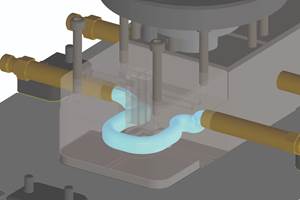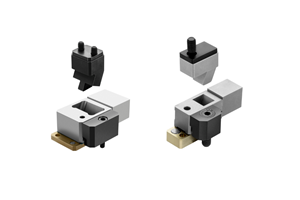Mold Base Advancements Set a New Standard
Further standardization and more options allow moldmakers to concentrate on fine detail.
The past several years have seen huge advances in the moldmaking industry overall, and mold bases are no exception. Gone are the days where every part of the process is performed in-house - the buzzword of late is standardization. Moldmakers can buy off-the-shelf mold bases and fit inserts within them. It's a totally new way of designing a mold and it's starting to catch on - more and more moldmakers are outsourcing standard mold bases to not only reduce leadtimes, but also to be able to focus on intricate core and cavity work.
Mold base suppliers have been meeting this demand for standardization and are even taking it a step further by offering more options on the mold bases as standard features. The idea is to do as much work to the mold base before it goes to the moldmaker so that he can complete the mold that much faster. Below, several suppliers discuss these developments in the mold base market and their impact on the moldmaking process as a whole.
Advancements Aplenty
According to Glenn Starkey, president of Progressive Components (Wauconda, IL) - a supplier of mold components, mold bases and hot runner systems - the market is experiencing even further standardization of mold bases, with more options being added as standard features. "It's easier now to relocate standard components and to add pockets, sidelocks, hot sprue bushings, etc. than in the past," he comments. "Previously, moldmakers bought basically off-the-shelf standard mold bases and took it from there. But now there is much more integration of additional machining options being provided by mold base manufacturers and at the right time. So, rather than contending with an off-the-shelf standard, new features and additional machining are being done as the mold base is being manufactured initially. There's more of an integration of services between the moldmaker and the mold base manufacturer."
In agreement is Gary Landless, sales manager of PCS Co. (Fraser, MI) - a manufacturer of mold components and standard mold bases. "With leadtimes being what they are, moldmakers are coming to us and asking - as the supplier of their standard mold bases and components - to do more and more basic work on the tool before it gets to them," he adds.
Dave LaFleche, sales manager of OMNI Mold Systems (East Hartford, CT) - a manufacturer of pre-designed and pre-manufactured components and mold systems - feels that his company has taken standardization to the highest level. "With standardized mold bases, everything is done to the frame - as far as pockets, guided ejection, supports, spring loaded returns, even hot sprue geometry - in advance and it's all put on the shelf so that the moldmaker can design around a standard mold base," he states. "In addition to that, we're at the point where we can take the moldmaker's files - after he's designed around the standard mold base - and do the finish work like ejector pin holes, side locks, water line clearances and cavity screw holes. The completed frame can then be shipped in five to seven days - allowing the moldmaker to just do the cavity and core inserts. The frame is then ready to accept them - you just fit inserts into the pockets, screw them in and the mold base is done."
This standardization is vital to speed up delivery times. "Another big development as of late are tools going to Canada and the Far East to be built," Landless of PCS notes. "It has a lot of our moldmakers concerned. They are used to their standard of living and wage level and now they are being forced to compete with people who are paying their moldmakers considerably less for the same job. So they need to complete jobs faster, and this is where the standardized mold bases come into play."
Landless adds that stainless steel also is growing in importance with mold bases, with many manufacturers choosing it because of corrosion resistance. "Although it's more expensive, it's important for longevity of the mold base," he says. "And, with the sophistication of the resins that are being manufactured - some being extremely corrosive - mold bases must be able to withstand the materials being molded."
Bountiful Benefits
Standardization reduces design time, OMNI Mold Systems' LaFleche notes. "Everything is predetermined - you don't have to redesign where you are going to put your support posts, or where the guided ejection is going, etc.," he says. "So you only have to design the molding area - which saves time in design as well as time in the shop where they would normally have big CNC equipment milling pockets, drilling holes and installing guided ejection and spring-loaded returns. When the supplier modifies its standard mold bases - with your ejector pin holes, cavity screw holes, etc. - it also reduces time in manufacturing and assembly, because you don't have to do those final ejector pin holes and cavity screw holes. It's just a matter of fitting inserts.
"Many people are still from the old school, believing that you have to design from the part out," LaFleche continues. "We have reversed that; you can design from the mold base and fit your part into an existing pocket. It doesn't cost you any quality at all. In fact, the quality is improved because there is less room for error - everything is consistent over and over again. There's not a lot of fine-tuning going on, which happens with designing from the part out. Any replacement parts you order down the road will be repeatable."
Standardized mold bases are "really catching on now" LaFleche points out, because moldmakers are realizing the need to be more competitive with price and delivery. "First of all, how will you meet quicker delivery times if you cannot use standard, off-the-shelf modular type systems?" he questions. "Price-wise, it takes out a lot of shop work, as well as thinking and assembly time. It also takes the chances of any mistakes out of the picture."
Starkey of Progressive Components adds that when the moldmaker utilizes an outside source as an extension of its shop to do non-specialized core/cavity work, he can focus on cavity/core work and install finished cavities and cores in a completely machined mold base. "Not only can the moldmaker take on more work, but he also can actually grow sales without adding personnel or capital equipment," he states. "It's a means of responsibly managing his business - he can then make the most of the people and machines he already has in-house."
| Off-the-Shelf Inserts Reduce Delivery Time. |
| With the industry moving toward standardized mold bases, it's a natural progression to consider using off-the-shelf inserts, whether blank or unit. Blank inserts are installed inside the cavity and can be thought of as an insert within an insert. Manufacturers machine pockets in them so that the moldmaker has less machining to do. Unit inserts - also called rapid or quick-change inserts - are like miniature mold bases that fit inside the frame and are interchangeable with other inserts.
These inserts offer a number of benefits - including reduced mold cycle time, reduced post-mold shrinkage and warpage, and improved productivity. Several manufacturers feature a variety of both types of inserts. D-M-E Co. (Madison Heights, MI), OMNI Mold Systems (East Hartford, CT) and Pleasant Precision, Inc. (Kenton, OH) have blank (standard) inserts. Among the manufacturers supplying unit (rapid) inserts are Progressive Components (Wauconda, IL), Pleasant Precision, Inc. and D-M-E Co. According to Bob Starr, D-M-E's marketing services manager, the use of pre-machined, near-finished condition insert blocks and rounds eliminates the need for moldmakers to machine materials to required dimensions, thus allowing the moldmaker to concentrate on the core and cavity work and reducing the overall leadtime for mold completion. Additionally, the company's MoldFusion 3D metal printing process enables the building of solid metal mold inserts from powdered metals, which permits the ability to build cooling channels in mold inserts that conform to the shape of the mold core (conformal cooling). Starr notes that using these inserts can reduce cycle time in molding by 35 percent or more - saving molders operating costs because of more effective cooling and improved heat transfer technology. Using standard inserts in conjunction with standard mold bases allows toolmakers not only to minimize repetitious, not-so-profitable work in their shop, but also to maximize the advantages of using standardized systems, according to Dave LaFleche, OMNI Mold Systems sales manager. "This also eliminates any chance of scrap which can result in added costs. Because they are standard and off the shelf, they ship the next day - and many times the same day," LaFleche adds. Glenn Starkey - president of Progressive Components - saw a growing need for parts manufactured in a timely manner. The results of his company's research are rapid tooling inserts, which he defines as unit inserts compatible with standard mold frames, but with additional features available. "They eliminate many repetitive machining steps for moldmakers by including common standard features included in off-the-shelf items," he states. "Within the last year, we've expanded our line with additional ranges of inserts, frames and pocketed inserts - for which we provide the finished cavity/core steel. "Typically, rapid tooling inserts are utilized in either prototype applications or applications where there is going to be short production runs," Starkey adds. The president of Pleasant Precision, Inc. - Ron Pleasant - also did extensive research before introducing his line of inserts - including an expansion of cavity-ready inserts - approximately a year ago. "Our line has been around for years, but moldmakers have requested more customization in our offerings," he says. "So, we have put more detail in the inserts such as slides and lifters and stripper discs, as well as functionality in the master frames, such as unscrewing and three plate gating." Pleasant adds that today's moldmakers need to reduce the time it takes to build molds, and this is why more people are turning to these types of inserts. It's one of the many reasons why Gordon McTavish, president of Edmonton, Alberta-based Drader Manufacturing - a proprietary and custom molder for industries like oil and gas, food and material handling - chose to use unit inserts. "Using the inserts has allowed us to build a number of cavities and configurations so that we can run this mold with different inserts - we have one insert with eight cavities and the rest are single inserts," he states. "But, we can family those inserts so that we have a number of inserts running in the multiple unit die at any one time. If a customer has a limited run, we run his mold with someone else's and keep his costs down. Then we have less mold changes to do. And changeovers are very quick because all you do is hook onto the existing mold base." Tom Cornelison, molding department manager of Springfield, MO-based Positronics Ind., Inc., - a high-performance electrical connectors manufacturer - has been using the inserts for a number of years. "We wanted to try and increase our capacity while improving our production and efficiency," he notes. "Using the inserts also has minimized our downtime by improving setup time. We also feel that the overall quality of the part is a lot better because we are able to better control the flow and we can run the parts that are more similar in size in a family mold. There's a wider selection of parts that can be run together." Using standardized inserts in conjunction with off-the-shelf mold bases is just beginning to catch on in the industry. Not only is it an effective partnership with your supplier, but it also allows you to take on more work and offer quicker leadtimes - these are musts to stay competitive in today's marketplace. |
Related Content
Mold Innovations Power Unique Auto Lighting Elements on Hummer EVs
Diamond machining, electroforming of micro-optical inserts and modified latch-lock system help injection molds produce unique forward lighting elements.
Read MoreHow to Supply Cooling to Additive Tooling
Additive tooling provides limitless options for cooling a mold’s difficult-to-cool areas.
Read MoreWhat is Driving Mold Lifecycle Management Digitalization?
OEMs are looking to partner with suppliers to share and track data across the supply chain for advanced intervention and process management.
Read MoreTo the Next Level: Hot Runners, Mold Components Solutions and Services
Moldmaking can be a complex business, but things can be simplified with the right hot runner and mold component technologies and services.
Read MoreRead Next
How to Use Strategic Planning Tools, Data to Manage the Human Side of Business
Q&A with Marion Wells, MMT EAB member and founder of Human Asset Management.
Read MoreReasons to Use Fiber Lasers for Mold Cleaning
Fiber lasers offer a simplicity, speed, control and portability, minimizing mold cleaning risks.
Read MoreAre You a Moldmaker Considering 3D Printing? Consider the 3D Printing Workshop at NPE2024
Presentations will cover 3D printing for mold tooling, material innovation, product development, bridge production and full-scale, high-volume additive manufacturing.
Read More



















